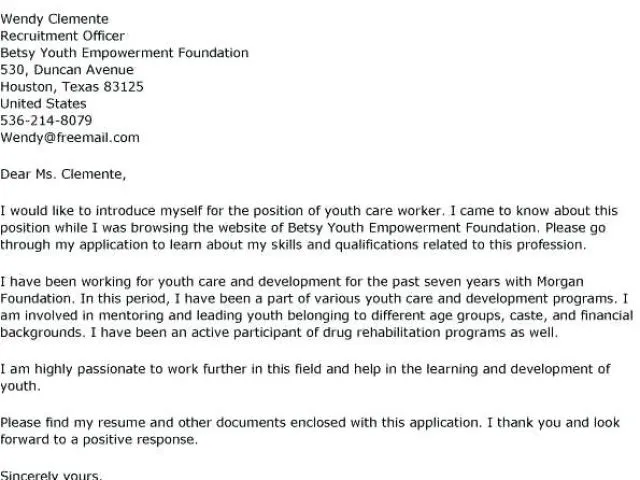Crafting Your Flight Attendant Cover Letter
A well-crafted flight attendant cover letter is your first impression, acting as your personal introduction to potential employers. It’s a crucial document, especially when you have no prior experience in the airline industry. This guide will help you create a compelling cover letter that highlights your skills, enthusiasm, and potential, increasing your chances of landing an interview and ultimately, your dream job. The key is to demonstrate that you have what it takes to excel, even without direct experience. By focusing on transferable skills, showcasing your personality, and tailoring your letter to each specific airline, you can stand out from the competition and make a memorable impression.
Understanding the Role of a Cover Letter
The primary function of a cover letter is to complement your resume and provide a narrative that brings your qualifications to life. It allows you to explain why you’re interested in the flight attendant position, elaborate on your relevant skills and experiences, and express your enthusiasm for the airline. Unlike your resume, which provides a factual overview, the cover letter allows you to show your personality, communication skills, and genuine interest in the company. It’s your opportunity to create a connection with the hiring manager and make a lasting impression. A strong cover letter transforms you from a list of qualifications into a relatable, enthusiastic, and qualified candidate, setting you apart from others.
Highlighting Transferable Skills
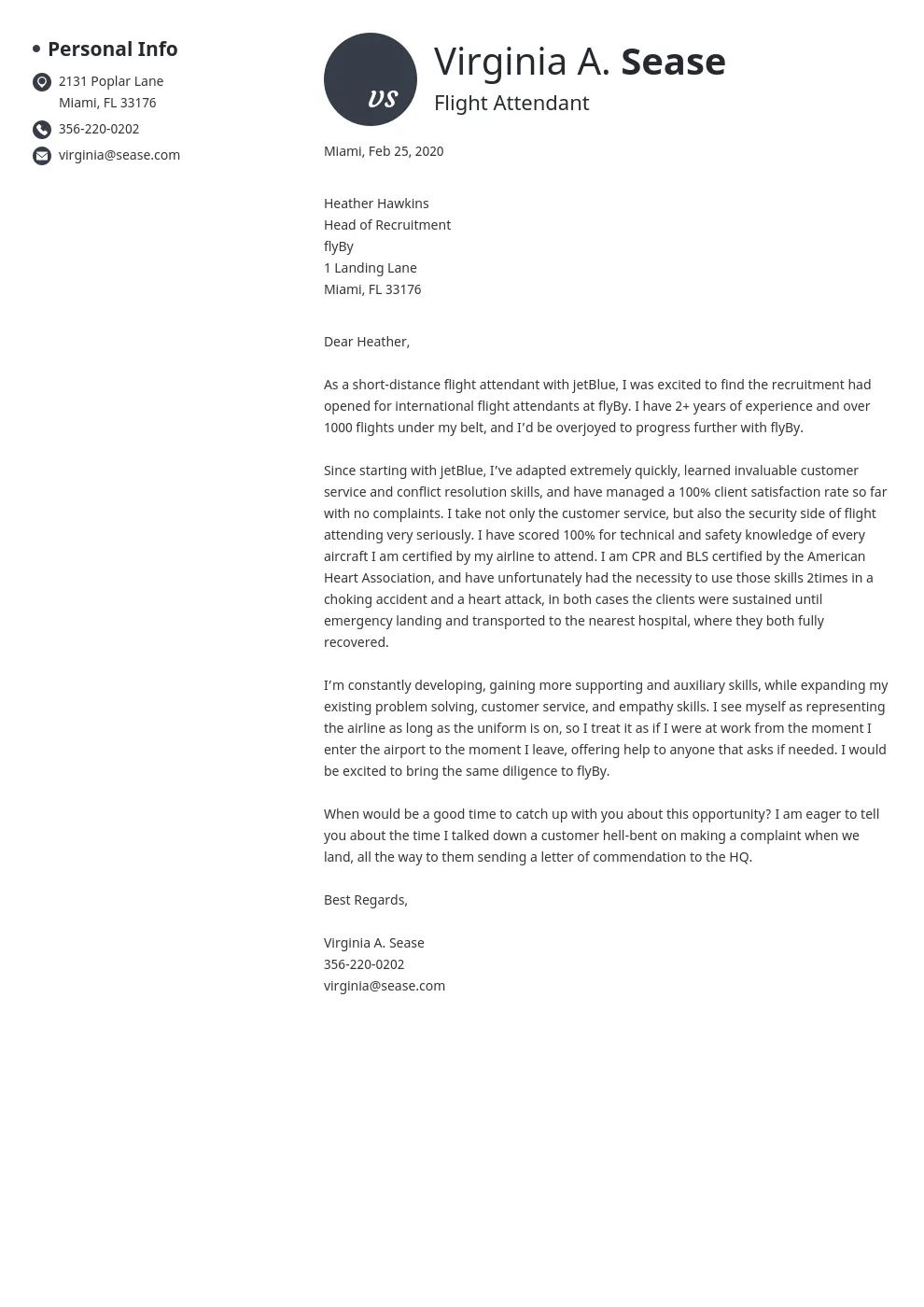
Since you may lack direct flight attendant experience, focusing on transferable skills is critical. These are skills you’ve acquired in previous jobs, volunteer work, or personal experiences that are relevant to the role of a flight attendant. Think about skills like customer service, communication, problem-solving, teamwork, and adaptability. How have you demonstrated these in past roles? Provide specific examples to show how you used these skills to achieve positive outcomes. For instance, if you’ve worked in retail, discuss how you resolved customer complaints or managed difficult situations. If you’ve volunteered, explain how you worked effectively with a team to accomplish goals. Transferable skills showcase your potential and readiness for the challenges of being a flight attendant.
Identifying Relevant Skills
Identifying relevant skills is the first step in creating a compelling cover letter. Research the job description thoroughly to understand the skills the airline values most. Common skills include excellent communication, empathy, problem-solving abilities, conflict resolution, and the ability to work under pressure. Consider your past experiences and identify situations where you utilized these skills. For example, if you have experience in hospitality, highlight your ability to provide excellent customer service and handle challenging situations. If you have experience in a leadership role, discuss how you managed teams, delegated tasks, and motivated others. Always quantify your achievements whenever possible to demonstrate the impact of your skills.
Showcasing Soft Skills
Soft skills, such as communication, interpersonal abilities, and adaptability, are highly valued in the airline industry. Highlight your ability to communicate effectively with people from diverse backgrounds, listen actively, and resolve conflicts with a positive attitude. Provide examples of situations where you successfully used these skills. For example, describe a time when you mediated a disagreement or handled a difficult customer with patience and understanding. Adaptability is crucial in the flight attendant role, as you must be prepared to work long hours, handle unexpected situations, and adapt to changing circumstances. Show how you’ve demonstrated flexibility and a willingness to learn in previous roles, volunteer experiences, or personal projects.
Researching Airline Values
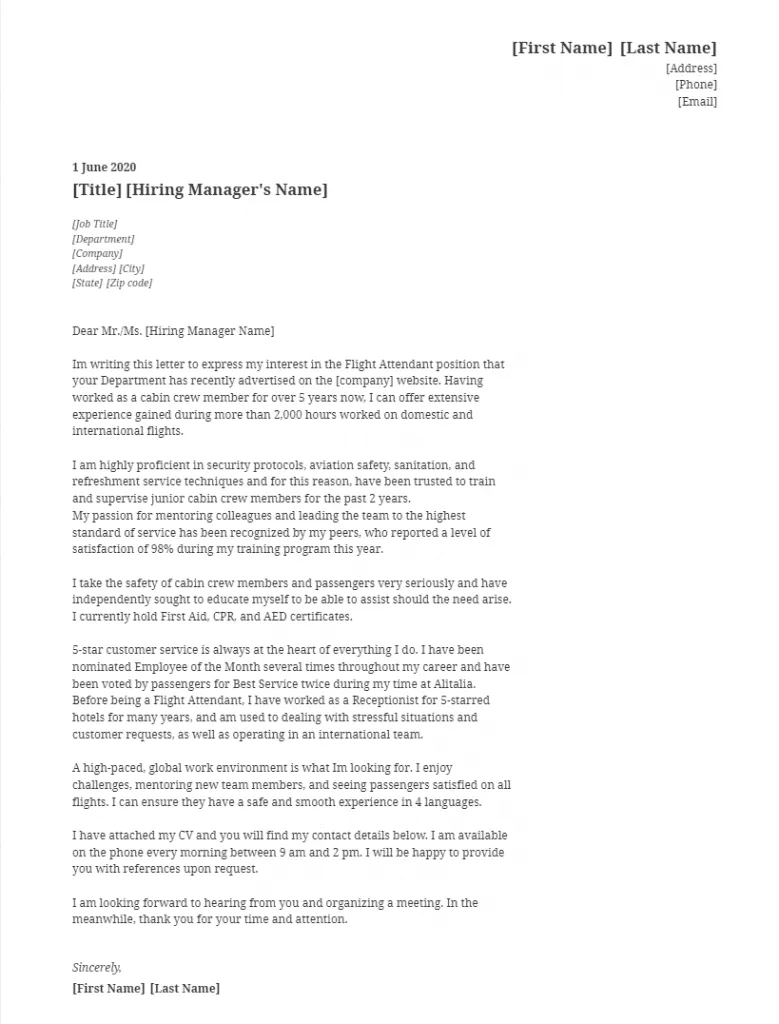
Thoroughly research the airline you’re applying to. Understand their mission, values, and company culture. Visit their website, read news articles, and check their social media presence to learn about their brand. Use this information to tailor your cover letter and demonstrate your genuine interest in the airline. Highlight how your skills and experiences align with their values. For example, if the airline emphasizes safety, mention your attention to detail or experience in a safety-conscious environment. If the airline values customer service, provide examples of your excellent customer service skills. Tailoring your letter shows that you’ve taken the time to understand the company and are a good fit for their culture.
Tailoring Your Cover Letter
One of the biggest mistakes job seekers make is sending generic cover letters. Tailoring your letter to each specific airline is essential. This means adjusting the content to match the specific requirements of the job description and the values of the airline. Start by personalizing the greeting. If possible, address the hiring manager by name (research to find this information). Reference specific aspects of the job description and explain how your skills and experiences meet those requirements. Show that you’ve researched the airline and genuinely want to work for them. This level of personalization demonstrates your commitment and professionalism and significantly increases your chances of getting an interview.
Addressing the Hiring Manager
Addressing the hiring manager by name is a small but powerful touch. It shows that you’ve taken the time to research the company and aren’t sending a generic letter. If you can’t find the hiring manager’s name, use a professional greeting, such as “Dear Hiring Manager.” Avoid generic greetings like “To Whom It May Concern.” Researching the name can often be done via LinkedIn or the airline’s website. A personalized greeting immediately grabs the reader’s attention and demonstrates that you’re serious about the position. If you have a contact, and it is acceptable, you could add their name after a short introduction about the position you are applying for, which will improve your chances of your letter being read.
Expressing Your Enthusiasm
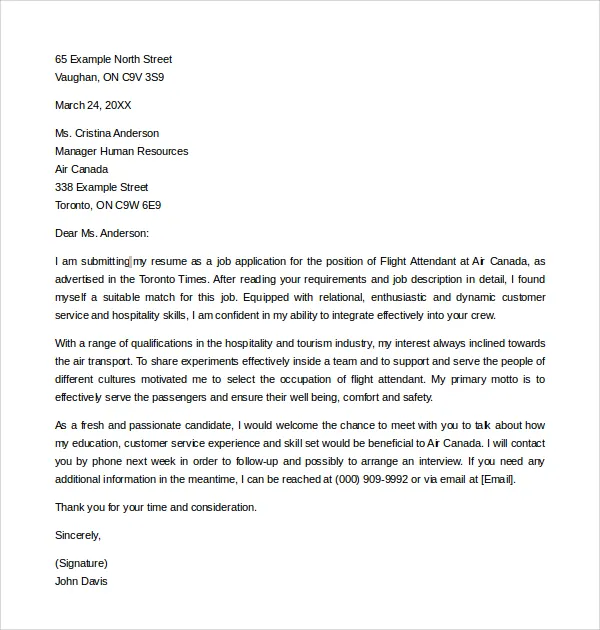
Express your genuine enthusiasm for the flight attendant position and the airline. Explain why you’re excited about the opportunity and what motivates you to pursue this career. Share your passion for customer service, travel, and helping others. Mention any personal connections you have to the airline or the industry. Show that you’re not just looking for a job but are genuinely interested in being a flight attendant. Your enthusiasm will shine through and make your cover letter memorable. A passionate candidate is more likely to make a positive impression on a hiring manager. Show your passion for customer service and travel in the most concise and appropriate terms possible.
Formatting and Structure
The formatting and structure of your cover letter are just as important as the content. A well-formatted letter is easy to read and makes a positive impression. Use a professional font, such as Times New Roman, Arial, or Calibri, in a standard size (11 or 12 points). Maintain consistent margins (1 inch on all sides) and use single-line spacing. Divide your letter into clear sections with headings and paragraphs. Ensure your letter is free of grammatical errors and typos. Pay attention to the overall layout and appearance of your cover letter. A clean, organized, and easy-to-read cover letter demonstrates your professionalism and attention to detail.
Cover Letter Formatting Essentials
Ensure your cover letter is visually appealing and easy to read. Use a standard font, such as Times New Roman, Arial, or Calibri, in a readable size (11 or 12 points). Use consistent margins (1 inch on all sides) to create a balanced look. Use single-line spacing to maintain a clean layout. Keep paragraphs concise and easy to follow. Use bullet points for lists to break up text and highlight key information. Proofread your cover letter carefully to eliminate any typos or grammatical errors. A well-formatted cover letter demonstrates your attention to detail and professionalism, which are essential qualities for a flight attendant.
Header and Contact Information
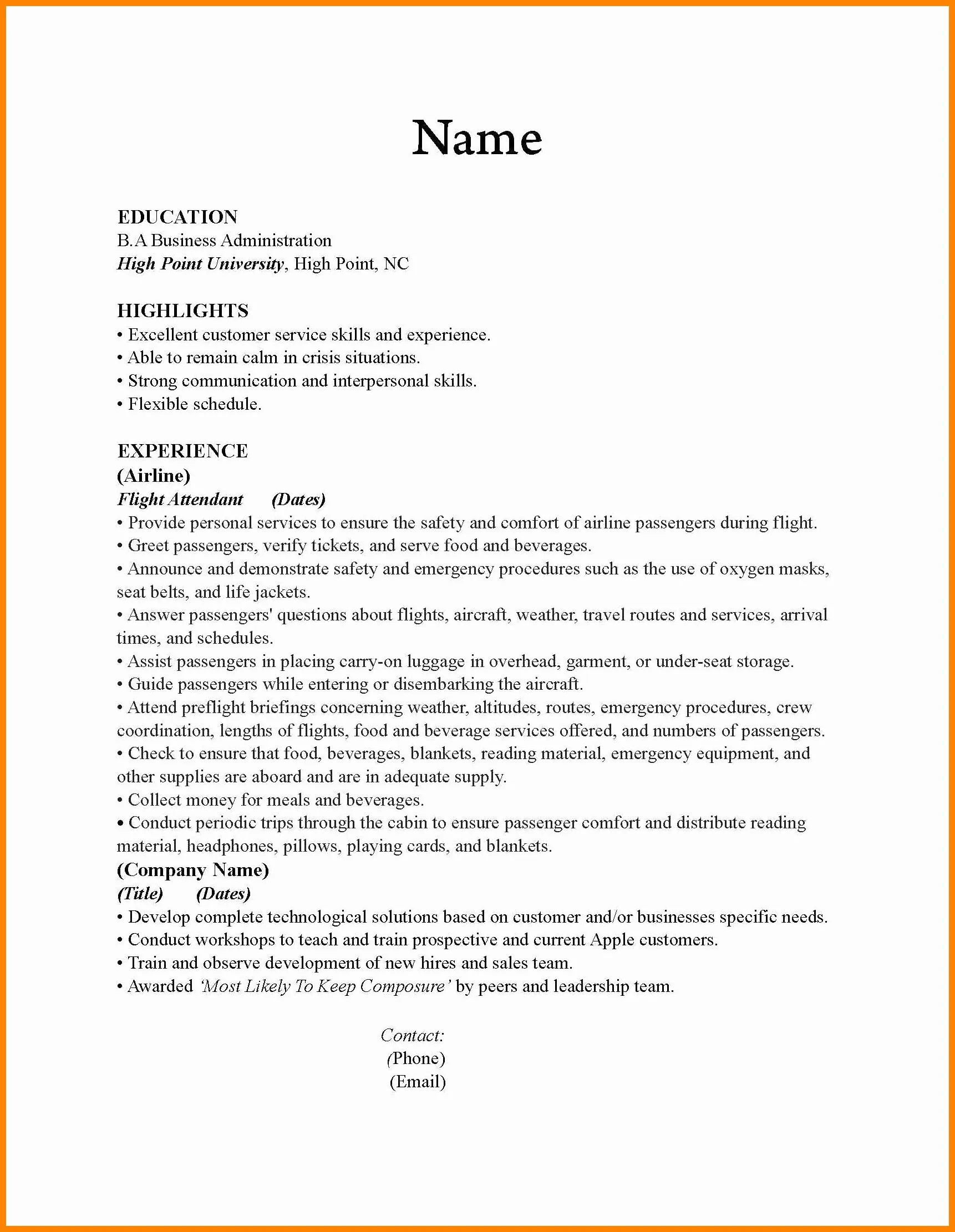
Start your cover letter with a professional header. Include your full name, address, phone number, and email address. Make sure your email address is professional and appropriate for job applications. Next, include the date and the hiring manager’s name, title, and the airline’s address (if known). This header provides essential contact information and demonstrates your professionalism. Ensure all information is accurate and up-to-date. The header sets the tone for the rest of your letter and makes it easy for the hiring manager to contact you.
Body Paragraphs for Impact
The body paragraphs of your cover letter are where you make your case. Use the first paragraph to state the position you’re applying for and how you found the job posting. Express your enthusiasm and briefly mention your key qualifications. The second paragraph is where you highlight your relevant skills and experiences. Provide specific examples of how you’ve demonstrated these skills in the past. The third paragraph should explain why you’re a good fit for the airline and what you can bring to the role. Always tailor these paragraphs to the specific requirements of the job and the values of the airline. This is where you show that you’ve done your research.
The Opening Paragraph
The opening paragraph is your first chance to make a strong impression. State the position you are applying for and where you found the job posting. Briefly mention your interest in the role and express your enthusiasm for the airline. Keep the tone professional and confident. Avoid generic opening statements; instead, try to create a hook to grab the reader’s attention. This could be a specific reason for applying, or a personal connection. The opening paragraph should set the stage for the rest of your letter and encourage the hiring manager to continue reading.
Showcasing Your Passion
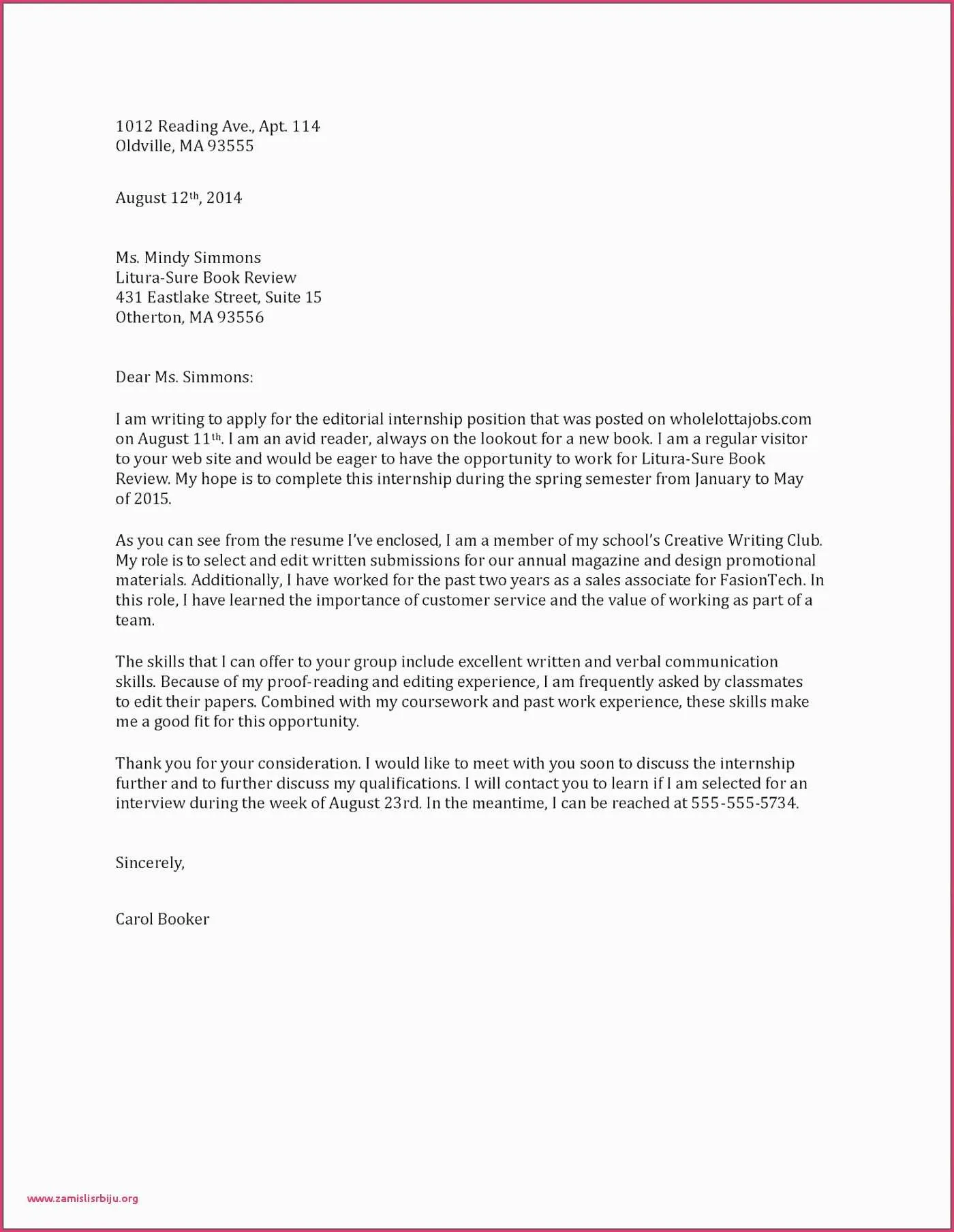
Showcasing your passion for the role is crucial in the opening paragraph. Briefly explain why you’re drawn to the flight attendant profession. Share your interest in customer service, travel, and helping others. Mention any personal connections you have to the airline or the industry, if applicable. Your enthusiasm will shine through and make your cover letter more engaging. A passionate candidate is more likely to make a positive impression on a hiring manager. Always remember to keep this section brief and enthusiastic, which will make it stand out from the rest.
Highlighting Your Qualifications
In your opening paragraph, briefly mention your key qualifications. Focus on the skills and experiences that are most relevant to the flight attendant position, even if you have no direct experience. For example, mention your customer service experience, communication skills, or problem-solving abilities. Tailor this to the job description and demonstrate your potential to excel in the role. This introduction sets the stage for a more detailed explanation of your qualifications in the following paragraphs and shows why you are a good fit for the position. Keep this part concise and to the point.
Closing Paragraphs
The closing paragraph is your opportunity to summarize your interest in the position and reiterate your qualifications. Thank the hiring manager for their time and consideration. Express your eagerness for an interview and provide your contact information again. Always use a professional closing, such as “Sincerely” or “Best regards.” Proofread your entire letter one last time to ensure it’s free of errors. A strong closing paragraph reinforces your message and leaves a positive, lasting impression on the hiring manager. The way you end a letter is just as important as the way you start.
Call to Action
End your cover letter with a clear call to action. State your interest in an interview and your availability for a follow-up. Mention that you look forward to hearing from them soon. Reiterate your contact information. A clear call to action encourages the hiring manager to take the next step and consider you for the position. This shows confidence and your eagerness for the opportunity. A well-defined call to action closes your cover letter professionally and gives the recruiter the necessary information to schedule an interview or contact you for further steps.
Proofreading and Editing
Proofreading and editing are essential steps in creating a professional cover letter. Carefully review your letter for any grammatical errors, typos, or formatting issues. Ensure that your language is clear, concise, and free of jargon. Read your letter aloud to identify any awkward phrasing or sentence structure. Ask a friend or family member to proofread your letter as well. A fresh pair of eyes can often catch mistakes that you might have missed. A well-proofread and edited cover letter demonstrates your attention to detail and professionalism. Poor spelling and grammar can instantly disqualify an applicant, so this step is vital.
Common Mistakes to Avoid
Avoid common mistakes to ensure your cover letter makes a positive impression. Don’t use generic cover letters; always tailor your letter to each specific job. Avoid typos, grammatical errors, and overly long sentences. Don’t include irrelevant information or negativity. Don’t be overly formal or informal. Avoid using jargon or clichés. Steer clear of exaggerations or lies. A well-written cover letter requires honesty and clarity. By avoiding these common mistakes, you can create a cover letter that highlights your skills, enthusiasm, and potential for the flight attendant position.
Ensuring Professionalism
Maintain a professional tone throughout your cover letter. Use proper grammar, spelling, and punctuation. Write in a clear, concise, and confident manner. Avoid slang, jargon, or overly casual language. Be respectful and polite in your communication. Make sure your email address and any other contact information are professional. Ensure that your cover letter presents you as a polished, professional candidate who is serious about the position and prepared for the demands of the role. Demonstrating professionalism enhances your credibility and increases your chances of getting an interview.
Cover Letter Examples for Inspiration
Reviewing cover letter samples can provide inspiration and guidance. Search online for flight attendant cover letter examples, especially those from candidates with no experience. Pay attention to how they highlight transferable skills, express their enthusiasm, and tailor their letters to specific airlines. Analyze the formatting, structure, and language used in the examples. Use these examples as a guide, but remember to personalize your cover letter and make it unique. Consider the different examples and how you can include similar information, using your own skills and interests. Tailoring your letter to showcase your personal strengths ensures you stand out.
Where to Find Cover Letter Templates
Many online resources offer cover letter templates that can help you structure your letter effectively. These templates provide a framework, but you must customize them with your information and tailor them to the specific job. Websites like Canva, Microsoft Word, and various job search platforms offer free and paid cover letter templates. Choose a template that suits your style and highlights your qualifications. Remember to modify the template to reflect your unique skills, experiences, and the specific requirements of the job. Make sure the chosen template aligns with the format and structure guidelines outlined in this guide for the best results.
